The What We Wore Exhibition finishes on 29th September 2023. You can visit the exhibition in the Drapers Room at St Mary’s Guildhall as part of a visit to the Guildhall. At certain times you can also visit the exhibition for a fee of just £1. Check the St Mary’s Guildhall website for details.
We were delighted to have Ilina Joshi join us this summer as an intern supported by the Warwick Institute of Engagement. As part of her work for us she provided support with the publicity and invigilation of the What We Wore exhibition at St Mary’s Guildhall. This exhibition had particular resonance for her as Indian citizen herself, currently studying in the UK. She shared her thoughts about the exhibition with us in this blog.
All images: Ilina Joshi
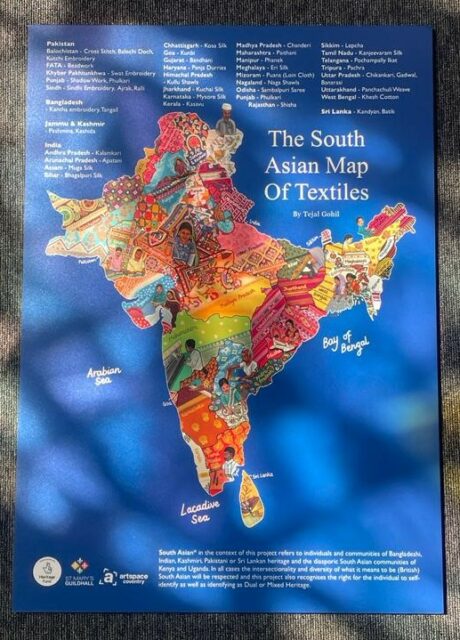
Artist Tejal Gohil’s map of South Asian textiles was commissioned especially for the exhibition and demonstrates the rich variety of textile work across the subcontinent.
One of the most stirring experiences during my internship with Artspace has been supporting Hardish Virk’s exhibition, “What We Wore: Stories of South Asian Textiles”. The exhibition draws on Hardish’s archive of diverse South Asian artefacts – each with its own distinct and recognizable story of struggle, resilience and community.
As an international Indian student, I’ve spent the last two years sculpting a new home and a new identity for myself in Coventry. The immigrant experience is littered with nostalgia, with uncertainty, with a yearning for the familiar and an instinctive apprehension of where one’s belonging truly lies. The immigrant odyssey, in my experience, is an unparalleled journey of becoming, characterised by longing, alienation, and adventures creating one’s own community within the duality of two cultures. When I was seventeen and electively migrated to start a life of my own, funnily enough, it never occurred to me how I was choosing an entirely unfamiliar life. Moving from a collectivist, homogenous culture to a multicultural society singularly obsessed with an individualistic way of life, each day would be characterised by an elation at the freedom to express myself in my own sweet way, coupled with a yearning for familiarity, for community.

Pictured above: A surprise cameo by the classic SRK! SRK or Shah Rukh Khan is one of Bollywood’s most celebrated actors, the loverboy of the 90’s.
Chancing upon Hardish’s archive was cathartic. I found there the connection to my heritage I’d been yearning for. The ‘What We Wore’ exhibition emerged as a repository of South Asian legacies, woven together with threads of history, memory, and identity. To me, it is a treasure trove of nostalgia. From cherished Bollywood records that I’d grown up beside, to intricately crafted South Asian jewellery, to the captivating array of textiles that reflect the essence of South Asian attire. (My favourite might be the Shah Rukh Khan doll cheekily hidden in the corner of a windowsill!)
But it is the textiles that steal the spotlight—saris that shimmer with memories of sangeets or pujas, kurtas gracefully traverse a shift to westernized fashion, and the khadau chappals that symbolize the epic of the deity Ram, who embarked on a journey of self-discovery wearing the khadau chappals that resonate with today’s South Asian diaspora.
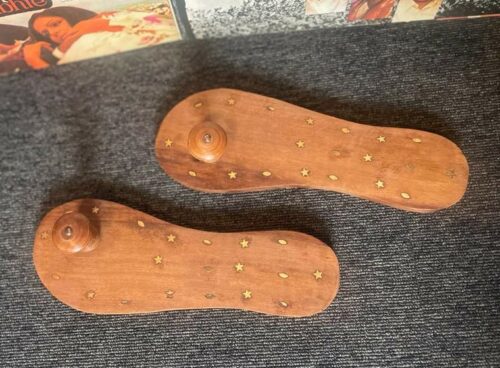
These ‘Khadau’ chappals were traditional South Asian footwear, said to have been around at the time of the ‘Ramayana’. Often worn by Jains, they were said to minimize impact on the ground, thus refraining from harming the earth or its inhabitants.
I’d be remiss to write of my experience of ‘What We Wore’ without recognizing the impact of the site hosting it. On my first visit to St Mary’s Guildhall, a place steeped in British history, I couldn’t help but marvel at the contrast the exhibition posed. The juxtaposition of an intimate reflection of South Asian heritage against the backdrop of this quintessentially British historical site was a powerful reminder of the intricate dual experience of South Asian immigrants. We straddle two worlds, enriching the British landscape with our stories, traditions, and customs, even as we continue to weave our own identities amidst the mosaic of cultures – regretfully, often losing sight of our own.
‘What We Wore’ mirrors this fusion, offering a platform to express a connection to our cultural roots and acknowledging our engagement with a foreign world. Walking through the exhibition, I find solace in the familiarity of the artefacts, each reminding me of stories passed down through generations. The music from Hardish’s Saregama Caravan maintains an aura of home – evoking a sense of lyrical nostalgia that transcends geographical boundaries, and allows me a sense of comfort I’ve only ever felt in India.
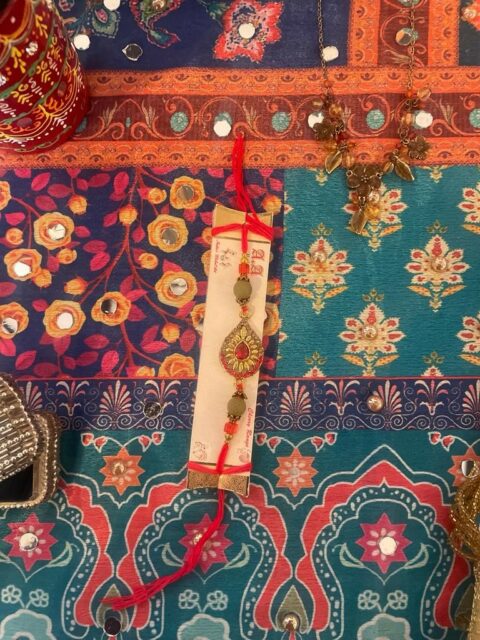
A ‘rakhi’ is a threaded bracelet symbolizing the love between a sister and a brother. Exchanged during the festival of Raksha Bandhan, sisters traditionally tie it to a brother’s wrist, say prayers, exchange sweets and presents, and vow to love and protect one another.
In one of my first conversations with Hardish, we spoke about the quintessentially South Asian tendency to fiercely hold on to our belongings – our artefacts. I was recounting a story of my habit to hoard sentimental trinkets and objects, passed down through generations, when Hardish passionately corrected me. “Collect”, not hoard. A simple semantical technicality succinctly captured the importance of honouring our cultural legacies (pardon the alliteration). Hardish reminded me how necessary it is for South Asians to acknowledge the heritage and memory that our private collections hold. Through his admonishment, I learnt to acknowledge erasure – the Western hegemony over culture and what we consider ‘art’ often pervades into our perspectives, creating implicit beliefs of bias and disconnection from our cultures. While we might consider an artefact passed down through generations in White families to be precious, honourable and unique, we sometimes forget to accord the same respect to our own legacies.
The ‘What We Wore’ exhibition is a haven for the South Asian community in Coventry. In an explicitly British setting, the memories and traditions of the South Asian diaspora thrive, beckoning to a future where our memories are rightfully honoured and recognized. Invigilating the exhibition and engaging with visitors, I’m struck by the diverse array of people who come to explore “What We Wore”, each with a distinct manner of relating to the artefacts, carrying with them their different histories.
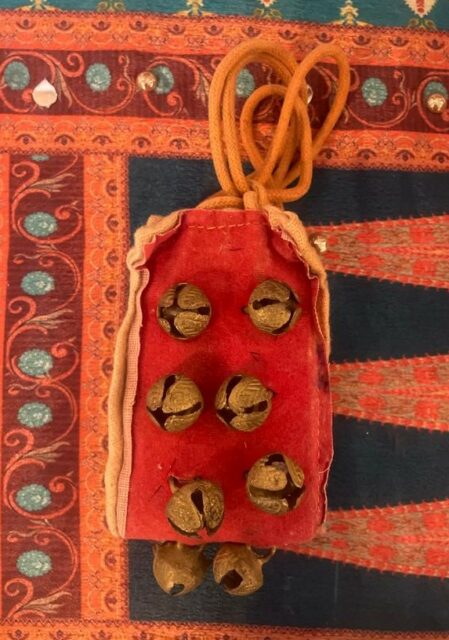
The ‘gunghroo’ is a musical anklet worn by classical Indian dancers, accentuating rhythmic melodies and symbolising the connection of the dancer to Mother Earth. The slew of tiny metallic bells allow complex footwork to be heard by the audience.
Many approach with curiosity, eager to learn more about the significance of a particular textile or the history behind a piece of jewellery. It’s heartening to see their genuine interest in South Asian culture, and affirming to be unapologetically acknowledging and respecting my roots. For some visitors, especially those of South Asian descent, the exhibition serves as a powerful reminder of their own experiences. I’ve had moving conversations with individuals who see their family stories mirrored in the artefacts on display, just as I do. They speak of familiar tales, of grandmothers draping elegant saris and mothers stitching memories into every piece of clothing. Every conversation is a reminder of the collective stories we share. For many, the exhibition is an emotional journey back in time, a tribute to the struggles that have paved the way for our present. A recognition and appreciation of the rich tapestry that binds us together as a community.
Through Hardish’s eyes, this exhibition isn’t just about textiles and artefacts; it is a portal into the past, a testament to the resilience of immigrants, and a celebration of cultural pluralism. It is a reminder that culture is not static; it evolves and adapts, yet retains its essence through generations – entirely deserving of the honour we often forget to accord it.
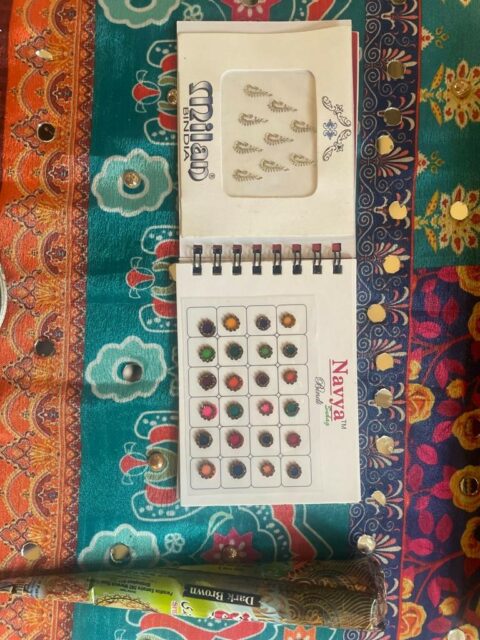
These sheets of ‘Bindis’ are a modern, creative take on the traditional black and red round bindis popular across South Asia. Next to them, a cone of ‘mehendi’ or henna completes the combination of everyday South Asian fashion.
I feel a profound sense of responsibility to share these stories, to bridge the gap between cultures and to pay homage to the legacies that have shaped us. I realise that my role as an intern has transformed into something more profound. I am inadvertently a storyteller, a custodian of memories, a bridge between cultures.
The exhibition has brought to life the stories that my family shared, the traditions that shaped my upbringing, and the immigrant journey that continues to define my experiences. Through this extraordinary collection, I’ve learnt that art isn’t confined to canvases and sculptures; it lives in the memories, emotions, and conversations it evokes. The exhibition reinforces the idea that culture is a fluid entity, one that transcends borders and defies categorization.
To me, the ‘What We Wore’ exhibition has been a journey of self-discovery into a cultural mosaic that is the essence of my identity. In the tapestry of life, every thread, no matter how diverse, has a place and a story to tell.

